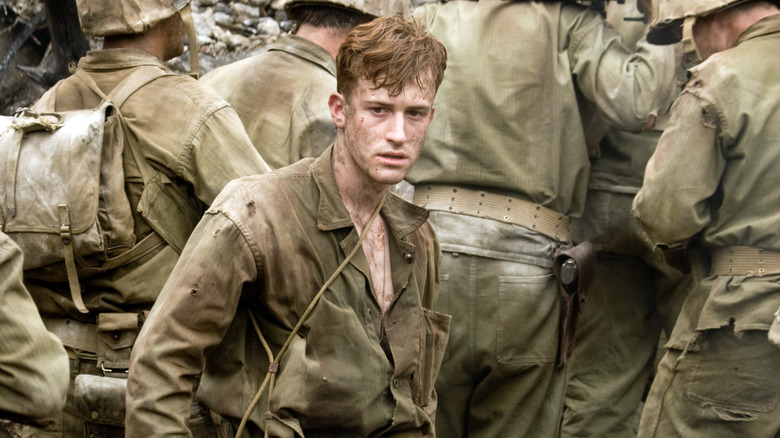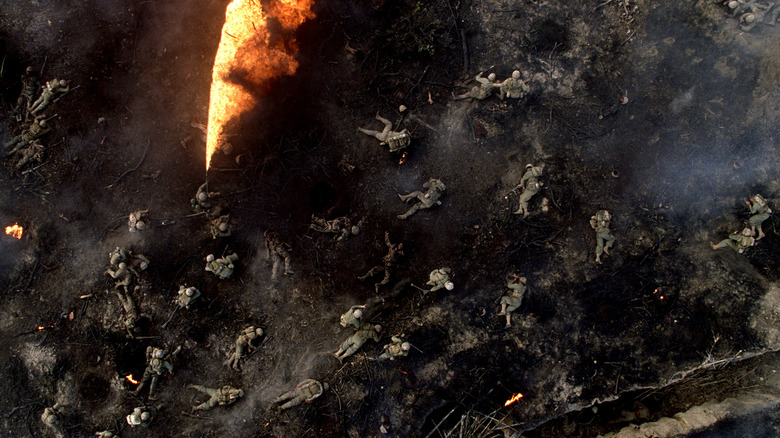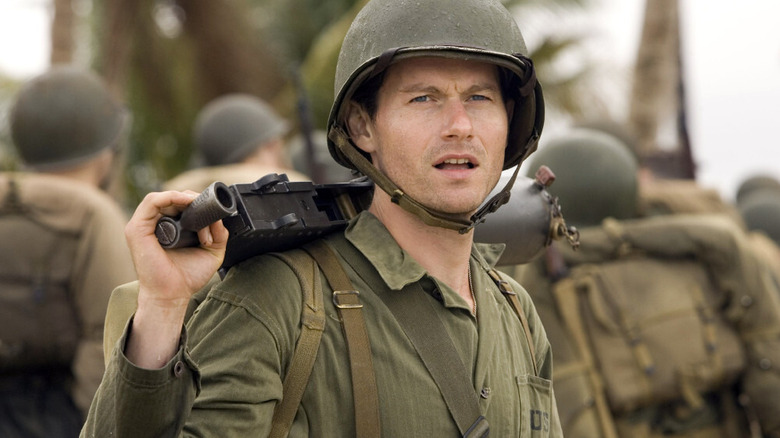This Beloved Steven Spielberg War Series Was One Of HBO's Most Expensive Shows Ever
These days, blockbuster budgets are the new normal for prestige TV series. "The Lord of Rings: The Rings of Power" became the most expensive show ever in 2022 at a staggering price of $58 million per episode, and the competitive streaming age has provided a ton of similarly costly series. Disney+ spent several years throwing veritable vaults full of money at its streaming originals, with "Andor" costing $650 million across two 12-episode seasons, and "WandaVision" reportedly clocking in at around $25 million per episode.
It wasn't that long ago when "Game of Thrones" season 8's $15 million per episode seemed like a record-breaking sum. You'd expect nothing less from the biggest TV show of all time, right? But just a few years on from that 2019 run, streaming has ballooned budgets well beyond what it cost to bring Westeros to life. Even Westeros itself has suffered the consequences, with the "Game of Thrones" prequel series "House of the Dragon" running at a reported per-episode cost of $20 million for its first season.
Put simply, yesterday's price is not today's price when it comes to "top-budget" television. However, if you scan through a current list of the most expensive TV seasons ever made, you'll find one anomaly. The top 30 or so in that competition have all come out in the last six years, save for a lone standout from 2010: the World War II miniseries and "Band of Brothers" follow-up, "The Pacific," produced (like its predecessor) by Tom Hanks and Steven Spielberg. So what made this one show so much more expensive than anything else that came before it?
The Pacific broke records for its expensive production design
At the time of its release back in 2010, "The Pacific" reported a production budget of just over $200 million for a 10-episode limited run. A per-episode budget of $20 million was unprecedented at the time, and no other show would hit that mark again for over a decade. However, at the time, the project didn't seem so absurd. First, it was a miniseries at HBO — a TV brand designed at the time to compete more with films than with traditional television. The network had spent the last 10 years setting the bar for production values and quality on TV so high that competitors were only just starting to catch up.
Second, "The Pacific" was the successor to "Band of Brothers," a show that itself became a cultural phenomenon when it premiered in 2001. "The Sopranos" was still in its early years at the time. No one had seen "The Wire" yet. In other words, "Band of Brothers" was one of the major pillars that built up HBO as the home for film-quality TV. The collaboration between Spielberg and Hanks at the time naturally evoked one of the director's biggest hits ever in "Saving Private Ryan," and that legacy could still be felt in "The Pacific."
That kind of pedigree put the show more in the company of Hollywood blockbusters than even other HBO shows. At the time, $200 million for a major motion picture certainly wasn't the norm, but it wasn't unprecedented either, with series like the "Pirates of the Caribbean" movies breaking that number around the same time.
Did The Pacific justify its budget at HBO?
Even if there were plenty of reasons to justify the massive budget for "The Pacific," it was still a risk. "The decision to proceed with this, knowing the price tag, was daunting," HBO programming president Michael Lombaro told The Hollywood Reporter back in 2010. "But everybody is proud of the result."
Logistically, the production justified its cost. The show's rendering of World War II's Pacific Theater demanded large-scale combat sequences, with significant money spent on pyrotechnics and blank munitions. And that's without mentioning the naval sequences. "We were shooting off pyrotechnics every day for almost a year, which is unprecedented," pyrotechnics expert Joss Williams told THR. "And the fact that we were using actors, rather than stunt people, meant I had to (make) the effects (ultra-safe)."
It's hard to precisely measure the financial success of "The Pacific." At the time, the network was still fully focused on maintaining its brand reputation to drive subscriptions, so while we could look at the 3.1 million viewers who tuned into the show's first episode, the value of "The Pacific" at the time had more to do with how it continued to prop up HBO's premium status. That said, the show was a critical success, and it won an Emmy for outstanding miniseries that same year.


